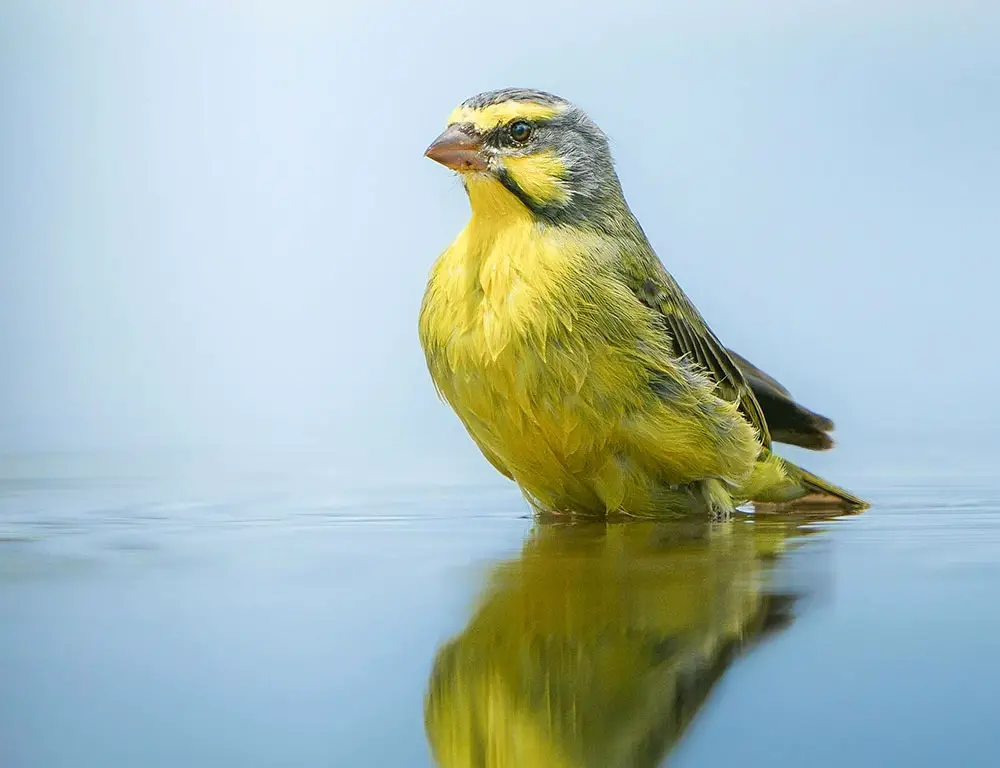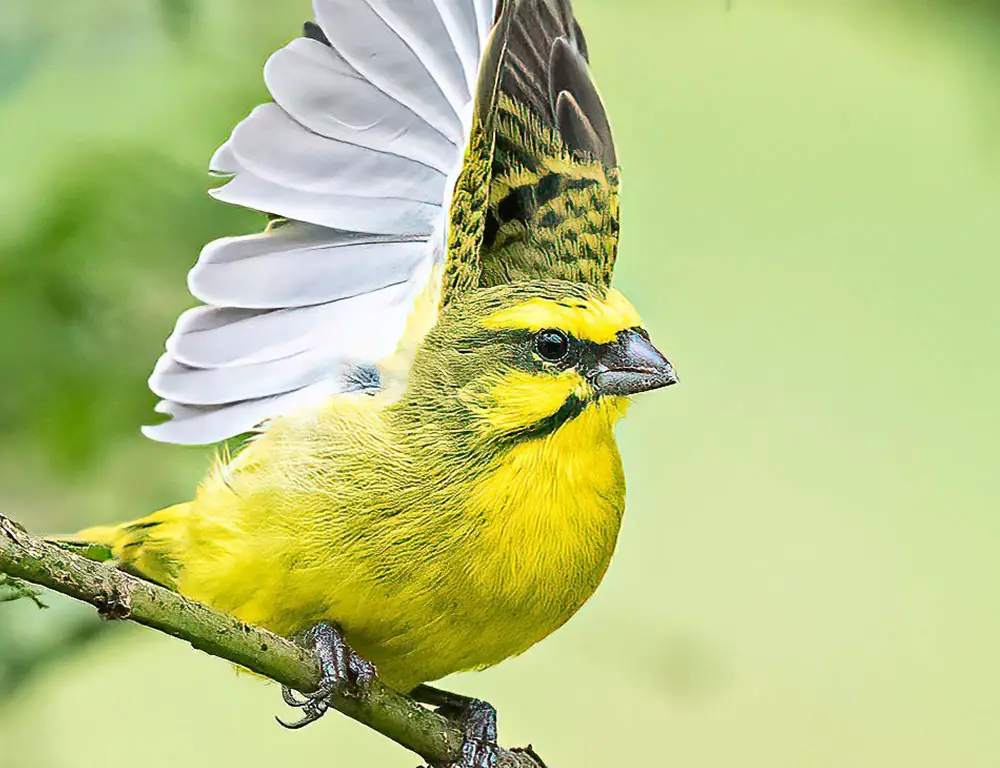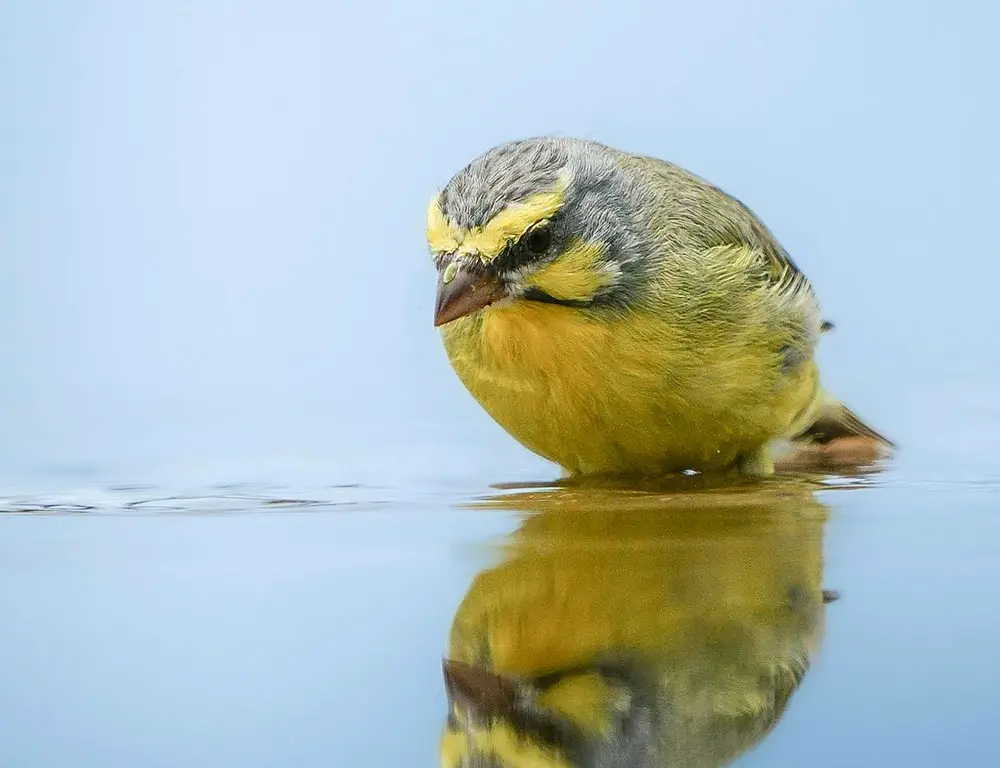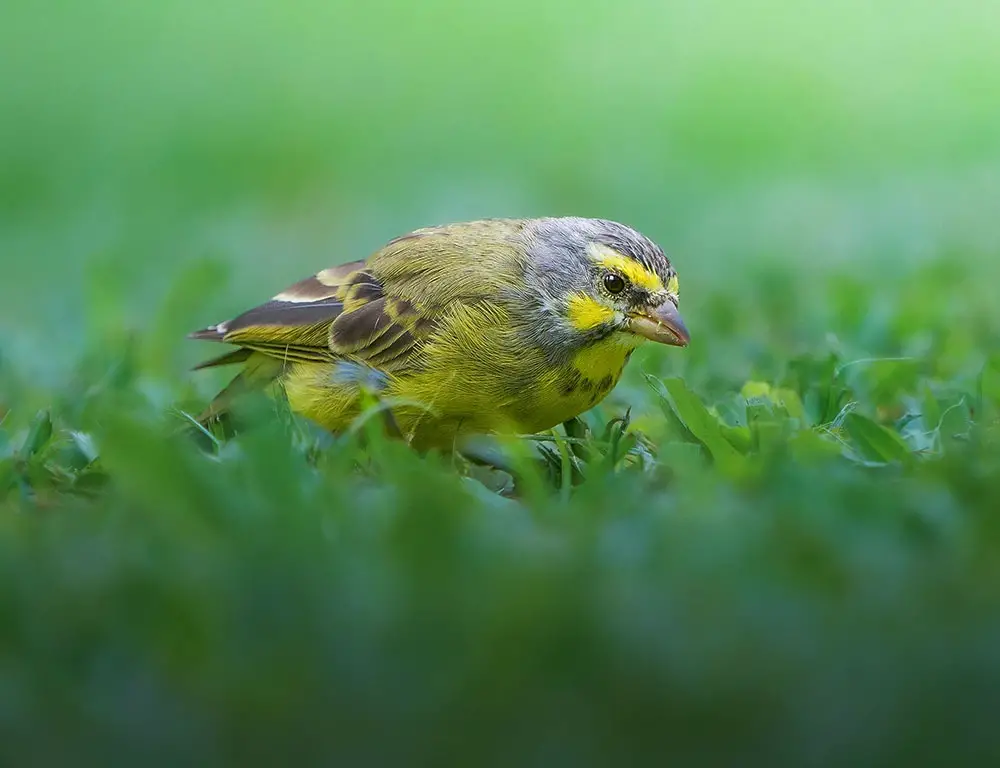The Yellow-Fronted Canary, scientifically known as Crithagra mozambica, is a charming passerine bird native to parts of Africa, particularly the southern and eastern regions.
Renowned for its vibrant plumage and melodious songs, this species captivates bird enthusiasts and researchers alike. Sporting a distinctive yellow patch on its forehead, which gives it its name, the Yellow-Fronted Canary exhibits a striking contrast against its predominantly greenish-yellow body.
Its delicate appearance is complemented by slender proportions and a graceful demeanor.
Beyond its visual appeal, this canary species is celebrated for its vocal abilities, with males often engaging in elaborate singing displays to attract mates or establish territories.
With a diverse diet consisting of seeds, fruits, and occasional insects, these adaptable birds are commonly found in various habitats, ranging from grasslands and savannas to cultivated areas and urban environments.

Physical Characteristics of Yellow-Fronted Canary
The Yellow-Fronted Canary (Crithagra mozambicus) possesses distinctive physical characteristics that make it easily identifiable and visually appealing.
Here’s an overview of its key physical traits:
Coloration
The most notable feature of the Yellow-Fronted Canary is its vivid yellow face, which serves as its namesake. This yellow coloration extends from the bird’s forehead to its chest, contrasting sharply with its grey-brown back and wings.
The wings and tail feathers also exhibit striking black barring, adding further contrast to its appearance.
Size and Shape
Yellow-Fronted Canaries are relatively small birds, typically measuring between 4 to 5 inches (11 to 13 centimeters) in length. Despite their small size, they possess a sleek and compact body with a streamlined shape.
They have sharp, pointed tails that contribute to their elegant silhouette. Regarding wingspan, Yellow-Fronted Canaries typically have a wingspan of approximately 7 to 8 inches (18 to 20 centimeters).
Sexual Dimorphism
There is slight sexual dimorphism in Yellow-Fronted Canaries, with males generally being slightly more extensive and more brightly colored than females.
During the breeding season, male canaries may exhibit even more vibrant colors to attract potential mates, with their yellow plumage becoming particularly intense.
Adaptations
The bright yellow face of the Yellow-Fronted Canary serves as an important visual cue for identification, particularly in dense vegetation where these birds often reside.
Their compact bodies and agile movements enable them to navigate efficiently through narrow spaces and dense foliage, contributing to their survival in their natural habitat.
Habitat and Distribution of Yellow-Fronted Canary

The Yellow-Fronted Canary (Crithagra mozambicus) is primarily found in sub-Saharan Africa, inhabiting various environments.
Here’s an overview of its habitat and distribution:
Natural Habitat
Yellow-Fronted Canaries thrive in diverse habitats across sub-Saharan Africa. They are commonly found in open woodland areas, grasslands, and human settlements such as gardens and crop fields.
They are adaptable birds and can also inhabit semi-arid savannahs and lush green forests. They often flit among treetops or dart through tall grasses within their preferred environments.
Range
The native range of the Yellow-Fronted Canary extends throughout sub-Saharan Africa. However, due to human intervention, they have been introduced to various other regions worldwide.
Some notable introductions include Bermuda, Puerto Rico, Hawaii, and Portugal. While not every introduction has succeeded, Yellow-Fronted Canaries have established robust populations in certain areas outside their native continent.
- Bermuda: Yellow-Fronted Canaries were introduced to Bermuda in the 1960s for pest control.
- Hawaii: First spotted in Hawaii in the late 1960s, they are now established on all main islands.
- Portugal (Madeira Islands): Found in the early 1980s, they have a thriving population on the Madeira Islands.
Behavior and Diet of Yellow-Fronted Canary

The Yellow-Fronted Canary (Crithagra mozambicus) exhibits fascinating behaviors and dietary preferences, contributing to its unique lifestyle.
Here’s an overview:
Behavior
- Social Interaction: Yellow-Fronted Canaries are social birds, often observed living in small flocks. They engage in various activities, including foraging, preening, and playful interactions such as mock fights. These social bonds contribute to their sense of security and well-being.
- Mating Rituals: During the breeding season, male Yellow-Fronted Canaries engage in elaborate courtship displays to attract mates.
These displays often involve singing complex songs and performing aerial maneuvers to impress females. Once pairs form, they remain monogamous throughout the breeding season. - Territoriality: Yellow-Fronted Canaries are known to defend territories, particularly during the breeding season. Males may vigorously defend nesting sites and feeding areas from intruders, displaying aggressive behavior when necessary.
- Interaction with Other Species: Yellow-Fronted Canaries often interact with other bird species, such as waxbills and bishops, mainly when foraging or roosting. These interactions may involve cooperative foraging or mutualistic relationships within mixed-species flocks.
Diet
Yellow-Fronted Canaries are primarily granivorous, meaning their diet mainly consists of seeds. They forage for seeds on the ground, as well as from grasses and other vegetation. In addition to seeds, they may also consume fruits and occasionally insects.
- Seeds: Seeds serve as the primary source of nutrition for the Yellow-Fronted Canaries. They have adapted to feed on various seeds from different plant species.
- Fruits: While seeds form the bulk of their diet, Yellow-Fronted Canaries may also consume fruits when available. Common fruits include apples, bananas, and berries.
- Insects: Although not a significant component of their diet, Yellow-Fronted Canaries may occasionally supplement their nutrition with insects, particularly during the breeding season when protein-rich foods are essential for egg production.
Conservation Status And Threats

The Yellow-Fronted Canary, widespread across sub-Saharan Africa, holds a conservation status of Least Concern on the IUCN Red List. Despite this classification, its population is declining.
Listed as a CITES Appendix III species, efforts to monitor and address threats such as habitat loss are crucial for ensuring the continued well-being of this iconic bird species.
Potential Threats
That’s not to say we should ignore these creatures’ well-being. Even species that appear to be thriving can experience sudden changes due to environmental shifts or human activity. For instance, habitat loss could potentially pose a threat in the future.
Impact of Pet Trade
In some regions, like Southern Africa, people keep the Yellow-Fronted Canaries as pets because of their melodious songs. However, this hasn’t drastically impacted wild populations because they breed readily in captivity.
This trend shouldn’t pose a significant risk if responsible pet ownership practices are followed.
Conclusion
The journey through the world of the Yellow-Fronted Canary reveals a fascinating blend of resilience, adaptability, and significance in our global ecosystem.
Beyond its vibrant colors and melodious song, this bird showcases remarkable lifestyle patterns, including monogamy and territorial defense.
Its successful spread across diverse environments, aided by human intervention, underscores its adaptability and resilience.
Moreover, the Yellow-Fronted Canary’s role as a model organism in scientific research highlights its invaluable contributions to advancing our understanding of avian biology.
However, challenges such as illegal trapping threaten its existence in the wild, emphasizing the need for urgent conservation efforts.
Let’s appreciate the Yellow-Fronted Canary for its beauty and vital role in our ecosystem, ensuring its continued presence enriches our lives and ecosystems alike.